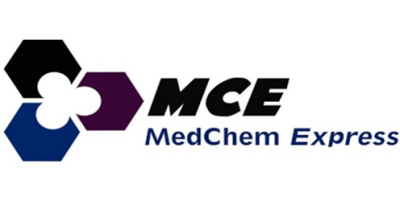

- Home
- Companies
- MedChemExpress LLC (MCE)
- Products
- MedChemExpress - Model Diazoxide - ...
MedChemExpress - Model Diazoxide - 364-98-7
Diazoxide (Sch-6783) is an ATP-sensitive potassium channel activator, has the potential for hyperinsulinism treatment.MCE products for research use only. We do not sell to patients.
Diazoxide
MCE China:Diazoxide
Brand:MedChemExpress (MCE)
Cat. No.HY-B1140
CAS:364-98-7
Synonyms:Sch-6783; SRG-95213
Purity:99.99%
Storage:4°C, protect from light *In solvent : -80°C, 6 months; -20°C, 1 month (protect from light)
Shipping:Room temperature in continental US; may vary elsewhere.
Description:Diazoxide (Sch-6783) is an ATP-sensitive potassium channel activator, has the potential for hyperinsulinism treatment.
In Vitro:Diazoxide (Sch-6783) has a number of physiological effects, including lowering the blood pressure and rectifying hypoglycemia. Diazoxide has powerful protective properties against cardiac ischemia[1].?Diazoxide (Sch-6783) could protect NSC-34 neurons against the main sources of neurodegenerative damage. Diazoxide increases Nrf2 nuclear translocation in NSC-34 motoneurons and prevents endogenous oxidative damage[2].
In Vivo:Diazoxide (Sch-6783) attenuates postresuscitation brain injury, protects mitochondrial function, inhibits brain cell apoptosis, and activates the PKC pathway by opening mitoKATP channels[3]. Treatment with Diazoxide (Sch-6783) in wild-type mice decreases intraocular pressure (IOP) by 21.5±3.2% with an absolute IOP reduction of 3.9 ± 0.6 mm Hg[4].
Animal Administration:Rats: Adult male Sprague-Dawley rats with induced cerebral ischemia (n=10 per group) receive an intraperitoneal injection of 0.1% DMSO (1 mL; vehicle group), diazoxide (10 mg/kg; DZ group), or diazoxide (10 mg/kg) plus 5-hydroxydecanoate (5 mg/kg; DZ + 5-HD group) 30 min after CPR. The control group (sham group, n=5) undergoes sham operation, without cardiac arrest. Mitochondrial respiratory control rate (RCR) is determined. Brain cell apoptosis is assessed using TUNEL staining. Expression of Bcl-2, Bax, and protein kinase C epsilon (PKCε) in the cerebral cortex is determined by Western blotting and immunohistochemistry[3]. Mouse: Diazoxide is prepared by diluting a 100 mM stock solution in 10% polyethoxylated castor oil in PBS. In C57BL/6 wild-type and Kir6.2(−/−) mice, a 5 μL drop of 5 mM diazoxide is topically administered to one eye of each mouse while the fellow control eye received vehicle (DMSO and 10% polyethoxylated castor oil in the same proportion as the treated eye). IOP is measured daily at 1 hour, 4 hours, and 23 hours following treatment. Treatment with diazoxide and vehicle is continued daily for 14 consecutive days[4].
Cell Assay:Diazoxide is dissolved in DMSO to prepare 50 mM stock solution. NSC-34 cells are allowed to differentiate for 8 weeks under reduced serum conditions and then seeded in 24-well plates. Glutamate is dissolved in culture medium and added to cultures at concentration of 10 μM for 24 h. Cell treatment with 100 µM diazoxide starts 2 h before glutamate exposure. Cell viability is measured by the MTT assay[2].
Hot selling product:Ixazomib citrate | Dipyridamole | Vorasidenib | GSK2334470 | Erythromycin | GSK621 | Mulberroside A | BCI | PEG2000-DSPE | Lichenase
Trending products:Recombinant Proteins | Bioactive Screening Libraries | Natural Products | Fluorescent Dye | PROTAC | Isotope-Labeled Compounds | Oligonucleotides
References:
[1]. Coetzee WA, et al. Multiplicity of effectors of the cardioprotective agent, diazoxide. Pharmacol Ther. 2013 Nov;140(2):167-75. [Content Brief]
[2]. Virgili N, et al. K(ATP) channel opener diazoxide prevents neurodegeneration: a new mechanism of action viaantioxidative pathway activation. PLoS One. 2013 Sep 11;8(9):e75189. [Content Brief]
[3]. Wu H, et al. Diazoxide Attenuates Postresuscitation Brain Injury in a Rat Model of Asphyxial Cardiac Arrest by Opening Mitochondrial ATP-Sensitive Potassium Channels. Biomed Res Int. 2016;2016:1253842. [Content Brief]
[4]. Chowdhury UR, et al. ATP-sensitive potassium (K(ATP)) channel openers diazoxide and nicorandil lower intraocular pressure in vivo. Invest Ophthalmol Vis Sci. 2013 Jul 22;54(7):4892-9. [Content Brief]
Brand introduction:
• MCE (MedChemExpress) has a global exclusive compound library of more than 200 kinds, and we are committed to providing the most comprehensive range of high-quality small molecule active compounds for scientific research customers around the world;
• More than 50,000 highly selective inhibitors and agonists are involved in various popular signaling pathways and disease areas;
• The products cover a variety of recombinant proteins, peptides, commonly used kits, more PROTAC, ADC and other characteristic products, widely used in new drug research and development, life science and other scientific research projects;
• Provide virtual screening, ion channel screening, metabolomics analysis detection analysis, drug screening and other professional technical services;
• It has a professional experimental center and strict quality control and verification system;
• Provide LC/MS, NMR, HPLC, chiral analysis, elemental analysis and other quality inspection reports to ensure the high purity and high quality of products;
• The biological activity of the products has been verified by the experiments of customers in various countries;
• A variety of top journals such as Nature, Cell, Science and pharmaceutical patents have included the scientific research results of MCE customers;
• Our professional team tracks the latest pharmaceutical and life science research and provides you with the latest active compounds in the world;
• It has established long-term cooperation with the world's major pharmaceutical companies and well-known scientific research institutions。
